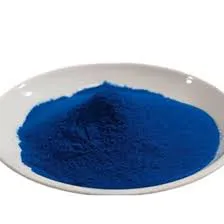Exporters of Indigo Dye Sources and Their Global Impact on Textile Industry
The Global Landscape of Indigo Dye Source Exporters
Indigo dye, revered for its deep blue hue and historical significance, has captured the imagination of cultures across the globe for centuries. Traditionally obtained from the indigofera plant, this dye has been used in textiles, art, and even in medicine. In recent years, the demand for natural indigo has surged as consumers increasingly seek sustainable and eco-friendly alternatives to synthetic dyes. This article explores the global landscape of indigo dye source exporters, focusing on their roles, challenges, and future prospects.
Historical Context
The history of indigo dyeing dates back thousands of years. Ancient civilizations, including those in Egypt, India, and the Americas, recognized the unique properties of indigo and developed techniques for extracting the dye. In India, indigo became a prominent export during the colonial period, where it played a significant role in the economy and influenced local culture. Despite the advent of synthetic dyes in the 19th century, the allure of natural indigo has never waned, leading to a notable resurgence in interest from artisanal communities and high-end fashion brands.
Current Exporting Countries
Today, India remains the largest producer and exporter of natural indigo, leveraging its rich history and diverse biodiversity. The Indian government has supported initiatives to revitalize traditional indigo farming practices while promoting sustainable cultivation. Apart from India, countries like Indonesia, Japan, and West African nations such as Nigeria and Ghana have also become significant players in the indigo market. Each of these regions has its unique methods of production, deeply rooted in cultural heritage, that attract international buyers looking for authenticity and sustainability.
Sustainable Practices
As the global fashion industry shifts towards greener practices, the demand for sustainably sourced indigo continues to rise. Exporters are now focusing on organic farming methods that eschew harmful pesticides, ensuring both safety for consumers and a lesser environmental impact. Additionally, some exporters are tapping into technology to enhance traditional methods, such as using fermentation processes that yield higher dye concentrations without degrading quality.
The shift towards sustainability often requires exporters to comply with international certifications and standards, such as GOTS (Global Organic Textile Standard) and OEKO-TEX. These certifications ensure that the products are not only organic but also produced under fair labor practices. The certification process can be lengthy and complex, posing a challenge for smaller exporters who may lack the resources to navigate these requirements.
indigo dye source exporters

Market Trends and Consumer Preferences
The market for natural indigo dye has seen a noteworthy transformation, driven by consumer consciousness about environmental sustainability and ethical production. High-end fashion brands and eco-conscious designers are increasingly incorporating natural indigo into their collections, fueling demand. This trend is particularly evident in regions like Europe and North America, where consumers are more informed about the origins of their products.
Social media platforms and digital marketing have also played a crucial role in promoting indigo dye. Artisans and exporters can now reach a wider audience, showcasing their unique products directly to consumers. This direct-to-consumer model not only increases visibility but also allows for a deeper connection between the artisans and their clients, fostering a sense of appreciation for the cultural heritage behind the dye.
Challenges Faced by Exporters
Despite its growing popularity, indigo dye source exporters face several challenges. One significant issue is competition from synthetic dyes, which are often cheaper and more readily available. Educating consumers about the benefits of natural dyes and their unique qualities, such as color depth and health safety, becomes essential for exporters.
Additionally, climate change poses a threat to the cultivation of indigo plants, with altered weather patterns affecting crop yields in many regions. Exporters must adapt to these changes, developing resilient farming practices to sustain their livelihoods.
Future Prospects
Looking ahead, the future of indigo dye source exporters appears promising, provided they can navigate the challenges posed by competition and environmental changes. Collaborations among exporters, artisans, and educational institutions can foster innovation and introduce new techniques that enhance product offerings.
In conclusion, the world of indigo dye source exporters is rich with history, culture, and potential. As consumers increasingly prioritize sustainability and ethical practices, these exporters have the opportunity to thrive. By embracing traditional methods while integrating modern technology and sustainable practices, they can continue to deliver the timeless beauty of indigo to future generations.
-
The Timeless Art of Denim Indigo Dye
NewsJul.01,2025
-
The Rise of Sulfur Dyed Denim
NewsJul.01,2025
-
The Rich Revival of the Best Indigo Dye
NewsJul.01,2025
-
The Enduring Strength of Sulphur Black
NewsJul.01,2025
-
The Ancient Art of Chinese Indigo Dye
NewsJul.01,2025
-
Industry Power of Indigo
NewsJul.01,2025
-
Black Sulfur is Leading the Next Wave
NewsJul.01,2025

Sulphur Black
1.Name: sulphur black; Sulfur Black; Sulphur Black 1;
2.Structure formula:
3.Molecule formula: C6H4N2O5
4.CAS No.: 1326-82-5
5.HS code: 32041911
6.Product specification:Appearance:black phosphorus flakes; black liquid

Bromo Indigo; Vat Bromo-Indigo; C.I.Vat Blue 5
1.Name: Bromo indigo; Vat bromo-indigo; C.I.Vat blue 5;
2.Structure formula:
3.Molecule formula: C16H6Br4N2O2
4.CAS No.: 2475-31-2
5.HS code: 3204151000 6.Major usage and instruction: Be mainly used to dye cotton fabrics.

Indigo Blue Vat Blue
1.Name: indigo blue,vat blue 1,
2.Structure formula:
3.Molecule formula: C16H10N2O2
4.. CAS No.: 482-89-3
5.Molecule weight: 262.62
6.HS code: 3204151000
7.Major usage and instruction: Be mainly used to dye cotton fabrics.

